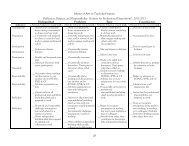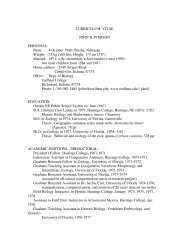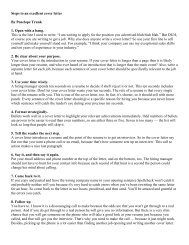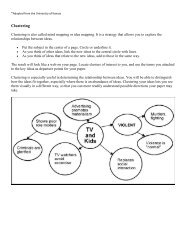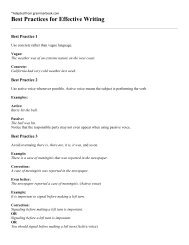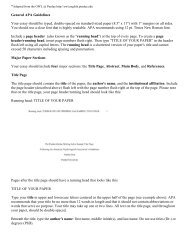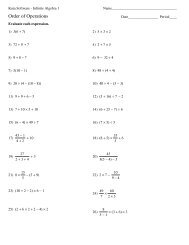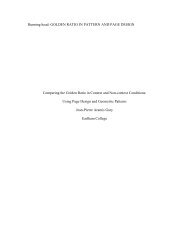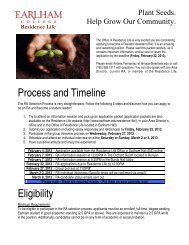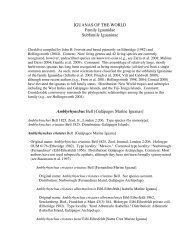NIH Biographical Sketch - Earlham College
NIH Biographical Sketch - Earlham College
NIH Biographical Sketch - Earlham College
You also want an ePaper? Increase the reach of your titles
YUMPU automatically turns print PDFs into web optimized ePapers that Google loves.
BIOGRAPHICAL SKETCHProvide the following information for the Senior/key personnel and other significant contributors in the order listed on Form Page 2.Follow this format for each person. DO NOT EXCEED FOUR PAGES.NAMERobert L. RosenbergeRA COMMONS USER NAME (credential, e.g., agency login)Robert_RosenbergPOSITION TITLEProfessor of Biology<strong>Earlham</strong> <strong>College</strong>EDUCATION/TRAINING (Begin with baccalaureate or other initial professional education, such as nursing, include postdoctoral training andresidency training if applicable.)INSTITUTION AND LOCATIONDEGREE(if applicable)MM/YYFIELD OF STUDYOberlin <strong>College</strong> A.B. 06/77 PhysicsYale University Ph.D. 05/85 PhysiologyYale University Postdoc 04/88 ElectrophysiologyPersonal StatementThe goal of this project is to continue my collaboration with Dr. Jennifer Morgan at MBL to discover the factorsthat prevent or promote the survival and regeneration of spinal cord neurons following injury. We have twogoals: 1) To test the hypothesis that the expression of voltage-gated Na channels is decreased in lampreyspinal axons as those neurons regenerate and re-connect after spinal cord injury; and 2) to obtain evidencethat the resulting decrease in excitability helps these neurons regenerate.Employment history1977-1979 Research Assistant, Biochemistry, Brandeis University (for Dr. Chris Miller)1988-2009 Assistant, Associate, and Full Professor, Departments of Pharmacology and Cell & MolecularPhysiology and Curriculum in Neurobiology, University of North Carolina at Chapel Hill2005-2006 Visiting Professor of Biology, Carleton <strong>College</strong>, Northfield, Minnesota2009-present Professor, Department of Biology, <strong>Earlham</strong> <strong>College</strong>, Richmond, IndianaProfessional MembershipsSociety for NeuroscienceFaculty for Undergraduate Neuroscience (Councilor 2011-2014)Society of General PhysiologistsAmerican Physiological SocietyAwards and honors1990-1995 American Heart Association Established Investigatorship Award2007 Teacher-Mentor Award (with Matthew Sternfeld), Society for Neuroscience2007 Finalist for University Professor of Distinguished Teaching Award, UNC-Chapel Hill2013 Baccalaureate message, invited by the <strong>Earlham</strong> <strong>College</strong> senior class, “Conformational Change”Research grants (completed)1988-1993 <strong>NIH</strong> R29 NS26660 “Reconstitution of Neuronal Calcium Channels”1989-1993 American Heart Association Grant-in-Aid “Reconstitution of Cardiac Calcium Channels”1993-1998 <strong>NIH</strong> R01 HL 49449 “Modulation of Cardiac Calcium Channels in vitro”1994-1996 Hoechst Celanese Corporation, Basic Neuroscience Research Discovery Grant “DoesAlzheimer's β-amyloid protein form ion channels?”1998-2002 <strong>NIH</strong> P01 HL27430 “Mechanisms of Sudden Cardiac Death. Project 3: Modulation of Cardiac L-Type Calcium Channels”1998-2003 <strong>NIH</strong> R01 NS37317 “Reconstitution of Neuronal Nicotinic ACh Receptors”2000-2003 <strong>NIH</strong> R01 NS37317-03S1 “Reconstitution of Neuronal Nicotinic ACh Receptors” (MinoritySupplement for D. Eddins)2004-2009 <strong>NIH</strong> R01 DA017882 “Agonist-driven conformational changes in nAChRs”1
2012-2013 Great Lakes <strong>College</strong>s Association New Directions Initiative “Regeneration of the Spinal Cord: ANew Direction for a Molecular Pharmacologist” (phases I and II awarded)2013 Marine Biological Laboratory Whitman Center Awards (Charles Evans Foundation Award andthe Gerald Fischbach Award) “Changes in Sodium Channel Expression During Spinal CordRegeneration in Lamprey”Training grants (completed)1995-1999 Director of Graduate Studies, Department of Pharmacology, UNC-CH.P.I. of Training Grant T32 GM007040 “Predoctoral Training in Pharmacological Sciences”2006-2009 Director, Curriculum in Neurobiology, UNC-CH.P.I. of Training Grant T32 NS007431 “Research Training in the Neurosciences”Editorial responsibilities2011-2013 Founding editor of ERIN (Educational Resources in Neuroscience), Society for Neuroscience1988-present Reviewer for Molecular Pharmacology, Journal of Pharmacology and ExperimentalTherapeutics, Biophysical Journal, and othersSelected publications1. Miller C, Rosenberg RL (1979) A voltage-gated cation channel from fragmented sarcoplasmic reticulum.Effects of transition metal ions. Biochemistry 18, 1138-11452. Miller C, Rosenberg RL (1979) Modification of a voltage-gated K+-channel from sarcoplasmic reticulum bya pronase-derived specific endopeptidase. J. Gen. Physiol. 74, 457-4783. Coronado R, Rosenberg RL, Miller C (1980) Ionic selectivity, saturation, and block in a K+-selectivechannel from sarcoplasmic reticulum. J. Gen. Physiol. 76, 425-4464. Rosenberg RL, Tomiko SA, Agnew WS (1984). Reconstitution of neurotoxin-modulated ion transport by thevoltage-regulated sodium channel isolated from the electroplax of Electrophorus electricus. Proc. Natl.Acad. Sci. USA 81, 1239-12435. Rosenberg RL, Tomiko SA, Agnew WS (1984) Single-channel properties of the reconstituted voltageregulatedNa channel isolated from the electroplax of Electrophorus electricus. Proc. Natl. Acad. Sci. USA81, 5594-55986. Tomiko SA, Rosenberg RL, Emerick MC, Agnew WS (1986) A fluorescence assay for neurotoxinmodulatedion transport by the reconstituted voltage-activated Na channel from eel electric organ.Biochemistry 25, 2162-21747. Rosenberg RL, Hess P, Reeves JP, Smilowitz H, Tsien RW (1986) Calcium channels in planar lipidbilayers: Insights into mechanisms of ion permeation and gating. Science 231, 1564-15668. Rosenberg RL, Hess P, Tsien RW (1988) Cardiac calcium channels in planar lipid bilayers. L-typechannels and calcium-permeable channels open at negative membrane potentials. J. Gen. Physiol. 92, 27-549. Rosenberg RL, Chen X-h (1991) Characterization and localization of two ion-binding sites within the poreof cardiac L-type calcium channels. J. Gen. Physiol. 97, 1207-122610. Tsai L-M, Dillard M, Rosenberg RL, Gaido ML, Falk RJ, Finn AL (1991) Reconstitution of an epithelialchloride channel: Conservation of the channel from mudpuppy to man. J. Gen. Physiol. 98, 723-75011. Wang Y, Rosenberg RL (1991) Ethaverine, a derivative of papaverine, inhibits cardiac L-type calciumchannels. Molec. Pharmacol. 40, 750-75512. Hijioka T, Rosenberg RL, Lemasters JJ, Thurman RG (1992) Kuppfer cells contain voltage-dependentcalcium channels. Molec. Pharmacol. 41, 435-44013. Rosenberg RL, East JE (1992) Cell-free expression of functional Shaker potassium channels. Nature 360,166-16914. Wang Y, Townsend C, Rosenberg RL (1993) Regulation of cardiac L-type Ca channels in planar lipidbilayers by G-proteins and protein phosphorylation. Am. J. Physiol. 264 (Cell Physiol. 33), C1473-C147915. Haack JA , Rosenberg RL (1994) Calcium-dependent inactivation of L-type calcium channels in planar lipidbilayers. Biophys. J. 66, 1051-10602
16. Townsend C, Rosenberg RL (1995) Voltage-sensitive chloride channels from porcine cardiac sarcolemma.J. Membrane Biol. 147, 121-13617. Koplas PA, Rosenberg RL, Oxford GS (1997) The role of calcium in the desensitization of capsaicinresponses in rat dorsal root ganglion neurons. J. Neuroscience 17, 3525-353718. Desai SA, Rosenberg RL (1997) Pore size of the malaria parasite’s nutrient channel. Proc. Natl. Acad. Sci.USA 94, 2045-204919. Chen J, Capdevila JH, Zeldin DC, Rosenberg RL (1999) Inhibition of cardiac L-type calcium channels byepoxyeicosatrienoic acids. Molec. Pharmacol. 55, 288-29520. Lyford LK, Rosenberg RL (1999) Cell-free expression and functional reconstitution of homo-oligomeric α7nicotinic acetylcholine receptors into planar lipid bilayers. J. Biol. Chem. 274, 25675-2568121. Liu Q-Y, Rosenberg, RL (2001) Stimulation of reconstituted cardiac L-type calcium channels byextracellular ATP. Am. J. Physiol. (Cell Physiol.) 280, C1107-C111322. Eddins D, Lyford LK, Desai SA, Rosenberg RL (2002) Permeant but not impermeant divalent cationsenhance the activation of non-desensitizing α7 nicotinic receptors. Am. J. Physiol. (Cell Physiol.) 282,C796-C804.23. Lyford LK, Lee JW, Rosenberg RL (2002) Low affinity Ca 2+ and Ba 2+ binding sites in the pore of α7nicotinic acetylcholine receptors. Biochim. Biophys. Acta 1559, 69-7824. Eddins DE, Sproul AD, Lyford LK, McLaughlin JT, Rosenberg RL (2002) Glutamate 172, essential formodulation of L 247 T α7 ACh receptors by Ca 2+ , lines the extracellular vestibule. Am. J. Physiol. Cell Physiol.283, C1454-C146025. Lyford LK, Sproul AD, Eddins D, McLaughlin JT, Rosenberg, RL (2003) Agonist-dependent conformationalchanges in the extracellular domain of α7 nicotinic ACh receptors. Molec. Pharmacol. 64: 650-65826. McLaughlin JT, Fu J, Sproul AD, Rosenberg RL (2006) Role of the outer β sheet in divalent cationmodulation of α7 nicotinic receptors. Molec. Pharmacol. 70, 16-2227. McLaughlin JT, Fu J, Rosenberg RL (2007) Agonist-driven conformational changes in the inner β sheet ofα7 nicotinic receptors. Molec. Pharmacol. 71, 1312-131828. McLaughlin JT, Barron SC, See JA, Rosenberg, RL (2009) Conformational changes in α7 acetylcholinereceptors underlying allosteric modulation by divalent cations. BioMed Central Pharmacology 9, 1-1329. Barron SC, McLaughlin JT, See JA, Richards VL, Rosenberg RL (2009) The α7 nicotinic receptor allostericmodulator, PNU-120596, causes conformational changes in the extracellular ligand binding domain similarto acetylcholine. Molec. Pharmacol. 76, 253-263Selected contributions to books1. Agnew WS, Rosenberg RL, Tomiko SA (1986) Functional reconstitution of the voltage-regulated sodiumchannel from Electrophorus electricus. In "Ion Channel Reconstitution" (C. Miller, ed.), Plenum PublishingCorp., New York, pp. 307-3352. Tsien RW, Hess P, McCleskey EW, Rosenberg RL (1987) Calcium channels: Mechanisms of selectivity,permeation and block. Ann. Rev. Biophys. Biophys. Chem. 16, 265-2903. Tsien RW, Fox AP, Hess P, McCleskey EW, Nilius B, Nowycky MC, Rosenberg RL (1987) Multiple types ofcalcium channels in excitable cells. In "Proteins in Excitable Membranes" (B. Hille and D.M. Fambrough,eds.), Society of General Physiologists Series 41,167-1874. Rosenberg RL, McCleskey EW, Hess P, Tsien RW (1988) Cardiac calcium channels: Pore size andsymmetry of energy profile. In "Molecular Biology of Ion Channels" (Agnew, W.S., Claudio, T. andSigworth, F.J., eds.), Current Topics in Membranes and Transport, Vol. 33, Academic Press Inc., SanDiego, pp. 393-4135. Lyford LK, Rosenberg RL (2003) Reconstitution in planar lipid bilayers of ion channels synthesized in ovoand in vitro. Planar Lipid Bilayers (BLMs) and Their Applications (H.T. Tien and A. Ottova-Lietmannova,eds.). Membrane Science and Technology Series, Vol. 7. Elsevier Press, AmsterdamGraduate students, programs, and dissertation titles (UNC-Chapel Hill)1995 Patricia Koplas (Neurobiology) Desensitization of the capsaicin-activated current of dorsal root ganglionneurons3
1995 Claire Townsend (Pharmacology) Characterization of a chloride channel from cardiac sarcoplasmicreticulum1998 Aaron Kitzmiller (Neurobiology) Characterization of kinetic instability in the large-conductance calciumactivatedK + channel from rat brain1998 Lisa Lyford (Pharmacology) Characterization of α7 neuronal nicotinic acetylcholine receptors2000 Jianyong Chen (Physiology) Inhibition of cardiac L-type calcium channels by epoxyeicosatrienoic acids2003 Donnie Eddins (Pharmacology) Divalent cation regulation of neuronal α7 nicotinic acetylcholinereceptors2010 Sean Barron (Neurobiology) Mechanisms of positive allosteric modulation of neuronal α7 nicotinicreceptorsLaboratory projects with undergraduate students1995 Erin Kimbrell (<strong>College</strong> of the Holy Cross) Ion channels formed in planar lipid bilayers by Alzheimer’s β-amyloid protein1999 Sarah Tanguay (Bowdoin <strong>College</strong>) Modulation of the pharmacological properties of α7 neuronalnicotinic acetylcholine receptors expressed in Xenopus oocytes by extracellular divalent cations1999 Amy Henriott (Emory University) Inhibition of cardiac L-type Ca channels expressed in Xenopusoocytes by epoxyeicosatrienoic acids2001 RosaLinda Miyares (Macalester <strong>College</strong>) Does Ca 2+ influx through nicotinic ACh receptors desensitizecapsaicin receptors (VR1) in oocytes?2001 Jill Pruszka (University of Wisconsin – Whitewater) Ca 2+ -dependent modulation of agonist activation ofL255T α7 nicotinic ACh receptors2006 Rafiq Huda (Carleton <strong>College</strong>) Activation-driven conformational mobility of V77 and S185, residues inor near the ACh-binding pocket of α7 nicotinic receptors2006 Jennifer See (Carleton <strong>College</strong>) Agonist-, antagonist-, and allosteric modulator-driven conformationalchanges at postion Q47 and E44 of α7 nicotinic receptors2007 Ben Otopalik (Carleton <strong>College</strong>) Effects of the L9'T mutation in the transmemberane domain of α7nicotinic receptors on conformational changes in the extracellular ligand-binding domain2007 Vanessa Richards (Oberlin <strong>College</strong>) Influence of electrostatics on cysteine modification of α7 nicotinicreceptors2010 Sean McGuire, Ross Price, and Maryam Taheri (<strong>Earlham</strong> <strong>College</strong>) Drugs used to treat neuropsychiatricdisorders affect α7 nicotinic acetylcholine receptors2013 Avalokiteswari Kurup (<strong>Earlham</strong> <strong>College</strong>). Changes in sodium channel expression during spinal cordregeneration in lampreyCurrent teaching activities (<strong>Earlham</strong> <strong>College</strong>)Cells, Genes and Inheritance (BIOL 112)Topics in Neuroscience (BIOL 242)Cell Physiology (BIOL 341)Anatomy and Physiology I: Nervous and endocrine systems (BIOL 345)Anatomy and Physiology II: Cardiovascular, respiratory, renal, and digestive systems (BIOL 347)Neuropharmacology (BIOL 467)Previous teaching activities (University of North Carolina at Chapel Hill)Medical Physiology – 20 yearsMedical Pharmacology – 11 yearsCellular and Molecular Neurobiology – 15 yearsIntroduction to Molecular Pharmacology – 7 years4



